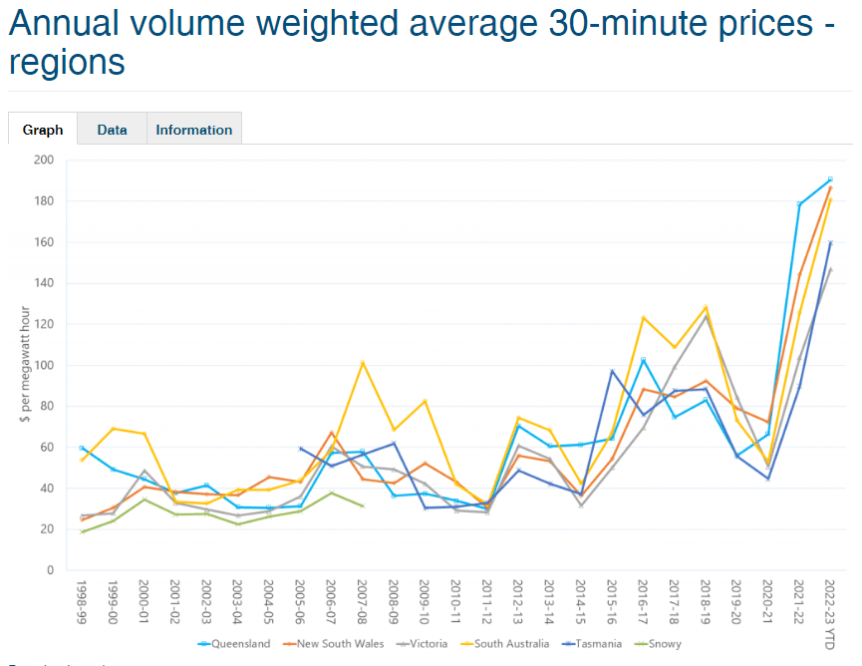In another, ‘we told you so’ moment, retail power prices in Australia will jump by 20% to 30% in June, following annual, double-digit increases every year, for the best part of a decade (see above).
$60 billion in subsidies (so far) to chaotically intermittent wind and solar was designed to wreck our conventional coal-fired power generation fleet, and true to purpose, that’s exactly what happened.
Now, politicians are working out cannot simply conjure up electricity out of nowhere; and you certainly can’t do it by praying to the wind and sun gods.
A few of them are retreating from their earlier plans to permanently shut down and wreck large coal-fired generating plants, recognising that the proles will be less than pleased. Pain a king’s ransom for power and then being left freezing in the dark is unlikely to be met with amusement among potential voters.
We’ll start with a look at how much Australia’s obsession with wind and solar is costing (already embattled) power consumers and follow-up with a piece from Sky News about how coal-fired power is, all of a sudden, flavour of the month, with politicians eager to keep the lights on.
Winter crunch looms as energy bills set to soar
The Australian
Perry Williams
16 March 2023
Power bills for households will surge by hundreds of dollars a year from July 1, adding to soaring cost-of-living pressures, with a further crunch in store after officials warned east coast states face gas shortages every winter until 2026.
Customers in Victoria face a 30 per cent jump on “safety net” prices, while households in NSW, South Australia and southeast Queensland will be hit with a 24 per cent increase.
Two separate draft default market offers – which put a price cap on what retailers can charge customers who have not looked for a better deal and remain on standing offers – were released on Wednesday.
The Victorian ruling by the Essential Services Commission estimates power costs will jump by $426 for residential customers to $1,829 a year while small businesses face bills surging by a third, or $1,738, a year to $7,358.
Residential customers on standard retail plans in NSW, South Australia and southeast Queensland face a slug of 19.5 per cent to 23.7 per cent depending on the region and power use, while small business customers face a rise of 14.7 per cent to 25.4 per cent.
Some 600,000 households are still on the default market offer in NSW, southeast Queensland and South Australia, with the whack adding to the pain of 10 successive interest rate rises and record inflation levels.
The price jump follows an 18 per cent increase on the default market offer last year.
….
The Australian
NSW will have ‘blackouts’ if Eraring closes in 2025
Sky News
Peta Credlin
7 March 2023
NSW will end up having “blackouts” and “outages” if the state government were to close Eraring Power Station in 2025, according to NSW One Nation Leader Mark Latham.
“Just to recap on what happened two years ago, Matt Kean passed legislation, One Nation voted against it 85 times, it was to go to 100 per cent renewables,” he told Sky News host Peta Credlin.
“A mad rush to 100 per cent renewables in just the decade and the Labor Party, and the National party, and the Greens all voted for it.
“And I gave warning after warning in that parliamentary debate that two things would happen, you would force the coal-fired power stations out early … and you won’t have the backup power … you’re losing baseload power, you’re having blackouts.”
Transcript
Peta Credlin: Hello. Let’s go to the issue of energy. We saw this, nothing more than chaotic, I don’t think how I can explain it any other way, from the Treasurer and the Premier yesterday. Matt Kean floated an intervention on the Eraring Coal-Fired Power Station set to close in two years’ time, just over 20% of New South Wales power would go when it closes. Perrottet then came out and said, “No, no, no, we’re not interested in that.” And then Kean later in the afternoon said, “Well, in fact, I was talking about a giant battery.” Chris Minns was the one who kept the same position all day, said he’s leaving the door open to buying back Eraring. Of course, they tried that with Liddell, AGL said no. And now there’s an application in to literally blow it up come the 28th of April, when it shuts down. This surely has got to be front of mind with voters, Mark.
Mark Latham:
Well, it should, Peta. We’ve got forecast from AEMO, the energy market operator, that New South Wales will be having outages, blackouts, particularly after the closure of Eraring in 2025.
And just to recap on what happened, two years ago, Matt Kean passed legislation. One Nation voted against it 85 times. It was to go to 100% renewables, a mad rush to 100% renewables in just a decade. And the Labor Party and the National Party and the Greens all voted for it. And I gave warning after warning in that Parliamentary debate that two things would happen. You would force the coal-fired power stations out early, and that’s happened with Eraring. And you won’t have the backup power, the pumped hydro and the gas peaking and the batteries in place to support wind and solar that don’t operate 24/7. You’re losing baseload power. You will have blackouts. The legislation then was a formula for blackouts. They voted against the One Nation position and now we’re going to have this economic and social disaster in New South Wales.
But Chris Minns, in talking about re-nationalising Eraring, buying it off Origin Energy. He’s got to realise that over the next two years, the company will run down the maintenance on that facility because it’s Minns’ own policy. And you’re probably only going to buy a facility where less than half the turbines are operational and you’re buying a conked-out asset. So, Minns doesn’t know what he’s doing here. He’s reversing the mistake he made two years ago in supporting Matt Kean 85 times in Parliamentary votes. But he still doesn’t know what he’s doing in paying money for an asset that’s obviously not going to have adequate maintenance to be a decent deal for the New South Wales taxpayers.
Peta Credlin: Just quickly, Mark Latham, if you’re in a position on election night to be a Lower House balance of power to determine, let’s say, minority government either way, would this be a key ask of you to form government with Labor or the Liberals?
Mark Latham: Oh, absolutely. Keeping the lights on, our whole economic and social future is the number one issue, the immediate issue for this election campaign. So, we’ve got to stop the transition to a so-called green energy economy. We’ve got to keep the reliable power system going for as long as we can. We need an extra gas peaking plant in New South Wales urgently. It needs to start tomorrow to build it, to keep the lights on. And we need to forget all the Matt Kean green energy madness. We’re not going to save the planet out of New South Wales. We’re not going to save the planet. We need to save the electricity grid and save people from the turmoil and disaster of blackouts.
Sky News




Totally agree with you Wal. I have a normal spread and number of friends and acquaintances and barely one in ten have any knowledge of or worse still, any interest in power problems. Many of them quote like some dystopian parrot how batteries will save us all even when it is pointed out that they are “secondary batteries” that have to be recharged after their 5 minutes or so of glory has been supplied. So the solar/wind not only has to supply the normal base load but also the energy to recharge the battery. Frankly I hope the system does collapse (without harming anyone) because having no lights in the house, no electricity to cook with and no gas hot water may and only may, cause people to think.
While I mostly blame politicians, bureaucrats, eggspurts and the media for this fiasco I think we shouldn’t forget the apathetic, gullible aussie in the street.
You don’t have to be an expert in anything to understand that unreliables can not replace the existing fossil fueled power generating grid.
A bit of reading and a bit of math is all the public need to do to understand the problems that unreliables have created and that blackouts will certainly be the case if eraring power station does close.
The governments of Australia have wasted $$$billions on unreliables and we, the public are paying the bill, not only in dollar terms but also in energy security.